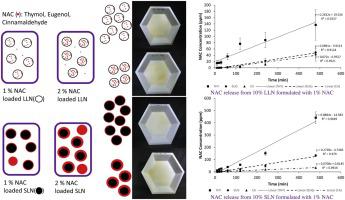当前位置:
X-MOL 学术
›
Food Packag. Shelf Life
›
论文详情
Our official English website, www.x-mol.net, welcomes your feedback! (Note: you will need to create a separate account there.)
Release kinetics of cinnamaldehyde, eugenol, and thymol from sustainable and biodegradable active packaging films
Food Packaging and Shelf Life ( IF 8 ) Pub Date : 2020-06-01 , DOI: 10.1016/j.fpsl.2020.100484 Bade Tonyali , Austin McDaniel , Jayendra Amamcharla , Valentina Trinetta , Umut Yucel
Food Packaging and Shelf Life ( IF 8 ) Pub Date : 2020-06-01 , DOI: 10.1016/j.fpsl.2020.100484 Bade Tonyali , Austin McDaniel , Jayendra Amamcharla , Valentina Trinetta , Umut Yucel

|
Abstract Active packaging films can be formulated with biodegradable polymer loaded with natural antimicrobial compounds (NAC) as biodegradable alternatives to traditional plastic packaging for food. Essential oil compounds, naturally found in the plants, have antimicrobial activity against microorganisms. In this work, they are encapsulated in liquid lipid nanoparticles (LLN) or solid lipid nanoparticles (SLN) to control and enhance their solubility and stability and control kinetic release. In this study, the release kinetics of thymol, cinnamaldehyde, and eugenol, from pullulan-based films were studied as a function of lipid structure (liquid vs solid) and carrier particle concertation. The crystallization temperature of SLN (10.2 °C) decreased with incorporation of NAC (6.8 °C in SLN loaded with 1 % cinnamaldehyde). Increasing NAC significantly decreased (p 0.05). The NAC release rate from SLN films was twice than that from LLN films due to higher aqueous partitioning. The release rate in SLN films increased 100 %, 50 %, and 5 % for thymol, eugenol, cinnamaldehyde, respectively, when NAC concertation in the particles increased from 1 % to 2 %. Thymol had highest release rate (0.93 ppm/min) from SLN loaded with 2 % NAC films than that of eugenol and cinnamaldehyde (0.40 and 0.15 ppm/min, respectively). This study shows that the NAC-loaded pullulan films can be used as active antimicrobial packaging film for food applications with controlled release of active compounds.
中文翻译:

从可持续和可生物降解的活性包装薄膜中释放肉桂醛、丁子香酚和百里酚的动力学
摘要 活性包装薄膜可以用负载天然抗菌化合物 (NAC) 的可生物降解聚合物配制,作为传统食品塑料包装的可生物降解替代品。植物中天然存在的精油化合物对微生物具有抗菌活性。在这项工作中,它们被封装在液体脂质纳米粒子 (LLN) 或固体脂质纳米粒子 (SLN) 中,以控制和提高它们的溶解度和稳定性并控制动力学释放。在这项研究中,百里酚、肉桂醛和丁子香酚从基于支链淀粉的薄膜中的释放动力学作为脂质结构(液体与固体)和载体颗粒协调的函数进行了研究。SLN 的结晶温度 (10.2 °C) 随着 NAC 的加入而降低(在负载有 1% 肉桂醛的 SLN 中为 6.8 °C)。增加 NAC 显着降低 (p 0.05)。由于较高的水分配,SLN 薄膜的 NAC 释放速率是 LLN 薄膜的两倍。当颗粒中的 NAC 协调从 1% 增加到 2% 时,SLN 薄膜中百里酚、丁子香酚、肉桂醛的释放率分别增加了 100%、50% 和 5%。与丁香酚和肉桂醛(分别为 0.40 和 0.15 ppm/min)相比,百里酚从负载 2% NAC 薄膜的 SLN 中具有最高的释放速率(0.93 ppm/min)。该研究表明,载有 NAC 的支链淀粉薄膜可用作食品应用的活性抗菌包装薄膜,可控制活性化合物的释放。当颗粒中的 NAC 协调从 1% 增加到 2% 时,百里香酚、丁子香酚、肉桂醛分别为 5% 和 5%。与丁香酚和肉桂醛(分别为 0.40 和 0.15 ppm/min)相比,百里酚从负载 2% NAC 薄膜的 SLN 中具有最高的释放速率(0.93 ppm/min)。该研究表明,载有 NAC 的支链淀粉薄膜可用作食品应用的活性抗菌包装薄膜,可控制活性化合物的释放。当颗粒中的 NAC 协调从 1% 增加到 2% 时,百里香酚、丁子香酚、肉桂醛分别为 5% 和 5%。与丁香酚和肉桂醛(分别为 0.40 和 0.15 ppm/min)相比,百里酚从负载 2% NAC 薄膜的 SLN 中具有最高的释放速率(0.93 ppm/min)。该研究表明,载有 NAC 的支链淀粉薄膜可用作食品应用的活性抗菌包装薄膜,可控制活性化合物的释放。
更新日期:2020-06-01
中文翻译:

从可持续和可生物降解的活性包装薄膜中释放肉桂醛、丁子香酚和百里酚的动力学
摘要 活性包装薄膜可以用负载天然抗菌化合物 (NAC) 的可生物降解聚合物配制,作为传统食品塑料包装的可生物降解替代品。植物中天然存在的精油化合物对微生物具有抗菌活性。在这项工作中,它们被封装在液体脂质纳米粒子 (LLN) 或固体脂质纳米粒子 (SLN) 中,以控制和提高它们的溶解度和稳定性并控制动力学释放。在这项研究中,百里酚、肉桂醛和丁子香酚从基于支链淀粉的薄膜中的释放动力学作为脂质结构(液体与固体)和载体颗粒协调的函数进行了研究。SLN 的结晶温度 (10.2 °C) 随着 NAC 的加入而降低(在负载有 1% 肉桂醛的 SLN 中为 6.8 °C)。增加 NAC 显着降低 (p 0.05)。由于较高的水分配,SLN 薄膜的 NAC 释放速率是 LLN 薄膜的两倍。当颗粒中的 NAC 协调从 1% 增加到 2% 时,SLN 薄膜中百里酚、丁子香酚、肉桂醛的释放率分别增加了 100%、50% 和 5%。与丁香酚和肉桂醛(分别为 0.40 和 0.15 ppm/min)相比,百里酚从负载 2% NAC 薄膜的 SLN 中具有最高的释放速率(0.93 ppm/min)。该研究表明,载有 NAC 的支链淀粉薄膜可用作食品应用的活性抗菌包装薄膜,可控制活性化合物的释放。当颗粒中的 NAC 协调从 1% 增加到 2% 时,百里香酚、丁子香酚、肉桂醛分别为 5% 和 5%。与丁香酚和肉桂醛(分别为 0.40 和 0.15 ppm/min)相比,百里酚从负载 2% NAC 薄膜的 SLN 中具有最高的释放速率(0.93 ppm/min)。该研究表明,载有 NAC 的支链淀粉薄膜可用作食品应用的活性抗菌包装薄膜,可控制活性化合物的释放。当颗粒中的 NAC 协调从 1% 增加到 2% 时,百里香酚、丁子香酚、肉桂醛分别为 5% 和 5%。与丁香酚和肉桂醛(分别为 0.40 和 0.15 ppm/min)相比,百里酚从负载 2% NAC 薄膜的 SLN 中具有最高的释放速率(0.93 ppm/min)。该研究表明,载有 NAC 的支链淀粉薄膜可用作食品应用的活性抗菌包装薄膜,可控制活性化合物的释放。


























 京公网安备 11010802027423号
京公网安备 11010802027423号